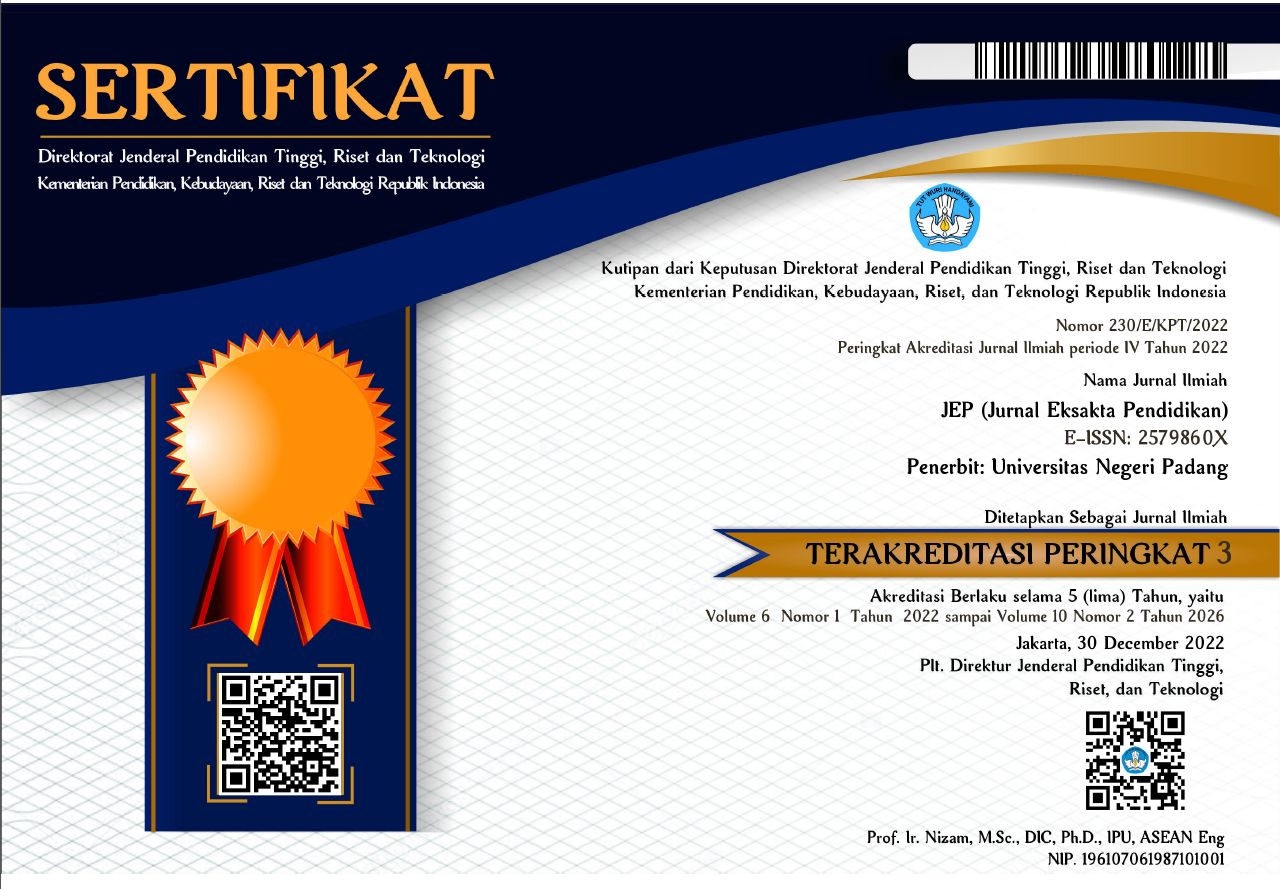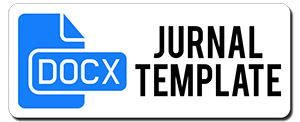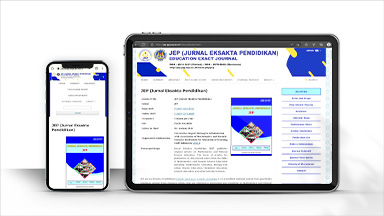Mathematics Literacy of Middle School Students with Socio-Cultural Context Viewed from Learning Style
Abstract
The capacity to comprehend, reason, create, recognize, and compute to solve any mathematical problem about day-to-day living is known as mathematical literacy. Learning style is each individual's method of receiving and understanding all the information they get. One aspect that influences students' mathematical literacy is the learning style aspect. This research goal is to find out how junior high school students' mathematical literacy relates to the socio-cultural context in terms of learning styles. This research uses a qualitative method with a descriptive approach. This research involved three students in class eight at SMP Negeri 1 Perak with different learning styles with equal abilities as subjects. The results of this research indicate that student’s learning styles influence students' mathematical literacy processes. The mathematical literacy of students who have an auditory learning style is better than the mathematical literacy of students who have a visual and kinesthetic learning style. Students' mathematical literacy has not been achieved using existing indicators.
Downloads
References
Aljaberi, N. M. (2015). University Students ’ Learning Styles and Their Ability to Solve Mathematical Problems Nahil M . Aljaberi Faculty of Arts University of Petra PO box 961342. International Journal of Business and Social Science, 6(4), 152–165.
Bire, A. L., Geradus, U., & Bire, J. (2014). Pengaruh Gaya Belajar Visual, Auditorial, Dan Kinestetik Terhadap Tingkat Pemahaman Akuntansi dan Prestasi Belajar Siswa. Kependidikan, 44(2), 168–178.
Cimermanová, I. (2018). The effect of learning styles on academic achievement in different forms of teaching. International Journal of Instruction, 11(3), 219–232. https://doi.org/10.12973/iji.2018.11316a
Hanggara, Y., & Suhardi, R. M. (2016). Esperimentasi Pendekatan Pembelajaran Pendidikan Matematika Realistik dan Pembelajaran Saintifik Terhadap Hasil Belajar Matematika Ditinjau Dari Gaya Belajar Siswa Kelas VIII SMPN 25 Batam Tahun Pelajaran 2015/2016. Revista CENIC. Ciencias Biológicas, 5(3), 1–13.
Kusuma, D., Sukestiyarno, Y. L., Wardono, & Cahyono, A. N. (2021). The Characteristics of Mathematical Literacy Based on Students’ Executive Function. European Journal of Educational Research, 11(1), 193–206.
Kusumawarti, E., Subiyantoro, S., & Rukayah. (2020). The effectiveness of visualization, auditory, kinesthetic (VAK) model toward writing narrative: Linguistic intelligence perspective. International Journal of Instruction, 13(4), 677–694. https://doi.org/10.29333/iji.2020.13442a
Leopold, L. (2012). Prewriting Tasks for Auditory, Visual, and Kinesthetic Learners. TESL Canada Journal, 29(2), 100–101. https://doi.org/10.18806/tesl.v29i2.1102
Masfufah, R., & Afriansyah, E. A. (2021). Mosharafa: Jurnal Pendidikan Matematika Analisis Kemampuan Literasi Matematis Siswa melalui Soal PISA. Mosharafa: Jurnal Pendidikan Matematika, 10(2), 291–300.
Musafir, R. R., & Susiswo, S. (2021). The strategies and errors of high school students’ in solving logarithmic inequalities. AIP Conference Proceedings, 2330(March). https://doi.org/10.1063/5.0043439
Nurwahid, M., & Ashar, S. (2022). A Literature Review: Efforts to Overcome Student’s Mathematical Literacy. Jurnal Eksakta Pendidikan (Jep), 6(2), 214–221. https://doi.org/10.24036/jep/vol6-iss2/666
OECD. (2019a). Pendidikan di Indonesia Belajar dari Hasil PISA 2018. Pusat Penilaian Pendidikan Balitbang Kemendikbud, 021, 1–206.
OECD. (2019b). PISA 2018 Assessment and Analytical Framework. In OECD Publishing.
OECD. (2022). Pisa 2022 Mathematics Framework ( Draft ). November 2018.
Pereira, J., Aulingga, A., Ning, Y., & Vilela, A. (2022). Kesalahan Siswa Smp Dalam Menyelesaikan Soal Pisa Konten Space and Shape Berdasarkan Teori Newman. JPMI (Jurnal Pembelajaran Matematika Inovatif), 5(2), 317. https://doi.org/10.22460/jpmi.v5i2.9910
Retnawati, H., & Wulandari, N. F. (2019). The Development Of Students’ Professional Self-Concept. 77(4), 816–824. https://doi.org/10.15405/epsbs.2018.09.95
Sulisawati, D. N., Lutfiyah, L., Murtinasari, F., & Sukma, L. (2019). Differences of Visual, Auditorial, Kinesthetic Students in Understanding Mathematics Problems. Malikussaleh Journal of Mathematics Learning (MJML), 2(2), 45–51. https://doi.org/10.29103/mjml.v2i2.1385
Sulistiana, Sriyono, & Nurhidayati. (2013). Pengaruh Gender , Gaya Belajar , Dan Reinforcement Guru Terhadap Prestasi Belajar Fisika Siswa Kelas Xi Sma Negeri Se-Kabupaten Purworejo. Radiasi: Jurnal Berkala Pendidikan Fisika, 3(2), 102–106.
Susanta, A., Sumardi, H., Susanto, E., & Retnawati, H. (2023). Mathematics literacy task on number pattern using Bengkulu context for junior high school students. Journal on Mathematics Education, 14(1), 85–102. https://doi.org/10.22342/JME.V14I1.PP85-102
Susanta, A., Sumardi, H., & Zulkardi, Z. (2022). Development of E-module Using Bengkulu Contexts to Improve Literacy Skills of Junior High School Students. Jurnal Pendidikan Matematika, 16(2), 171–186. https://doi.org/10.22342/jpm.16.2.17698.171-186
Syawahid, M., & Putrawangsa, S. (2017). Kemampuan literasi matematika siswa SMP ditinjau dari gaya belajar. Beta: Jurnal Tadris Matematika, 10(2), 222–240. https://doi.org/10.20414/betajtm.v10i2.121
Tarim, K., & Tarku, H. (2022). Investigation of the Questions in 8th Grade Mathematics Textbook in terms of Mathematical Literacy. International Electronic Journal of Mathematics Education, 17(2), em0682. https://doi.org/10.29333/iejme/11819
Tyas, P. A., & Safitri, M. (2017). Kinesthetic Learning Style Preferences: A Survey of Indonesian EFL Learners by Gender. JEES (Journal of English Educators Society), 2(1), 53–64. https://doi.org/10.21070/jees.v2i1.688
Vebrian, R., Putra, Y. Y., Saraswati, S., & Wijaya, T. T. (2021). Kemampuan Penalaran Matematis Siswa Dalam Menyelesaikan Soal Literasi Matematika Kontekstual. AKSIOMA: Jurnal Program Studi Pendidikan Matematika, 10(4), 2602. https://doi.org/10.24127/ajpm.v10i4.4369
Yanuarita, H. A., & Haryati, S. (2021). Pengaruh Covid-19 Terhadap Kondisi Sosial Budaya Di Kota Malang Dan Konsep Strategis Dalam Penanganannya. Jurnal Ilmiah Widya Sosiopolitika, 2(2), 58. https://doi.org/10.24843/jiwsp.2020.v02.i02.p01
Zulkardi, Z., & Putri, R. I. I. (2020). Supporting Mathematics Teachers to Develop Jumping Task Using PISA Framework (JUMPISA). Jurnal Pendidikan Matematika, 14(2), 199–210. https://doi.org/10.22342/jpm.14.2.12115.199-210
Copyright (c) 2024 Betita Nadia Fernanda, Ali Shodikin, Susanah Susanah

This work is licensed under a Creative Commons Attribution 4.0 International License.

This work is licensed under a Creative Commons Attribution 4.0 International License.




_(2579-860X).png)
_(2614-1221)1.png)




